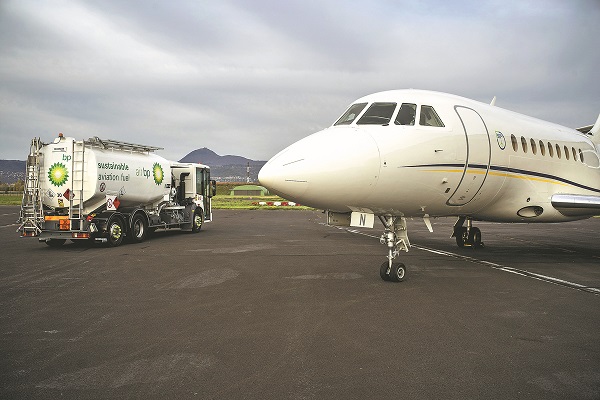Nation ready to soar in greener air travel

An Air bp truck carrying sustainable aviation fuel waits to refuel a jet at Clermont-Ferrand Auvergne Airport in France in October 2021. [Photo/China Daily]
Advantages pave way for country's leadership in aviation decarbonization
China is emerging as a global leader in aviation decarbonization, according to industry experts. This development is a result of the scale of the country's aviation market and its innovative technologies and policies aimed at reducing carbon emissions, they said.
"With China being the world's second-largest economy and expected to be the world's largest aviation market by 2030, we believe China has a leading role in aviation decarbonization with a deep impact on the decarbonization of aviation globally," said Martin Thomsen, senior vice-president of Air bp, the specialized aviation division of BP, previously known as British Petroleum, a London-based multinational.
Thomsen spoke in March during the Green Aviation Development Forum in Weihai, Shandong province.
"China is the leading global manufacturing hub for the world, with an edge and experience in technology and innovation to deliver an advancement in sustainable aviation fuel (SAF) production," he said.
"We believe that this will lead to an expansion of SAF production, which could supply domestic and global markets and play a key role in supporting the decarbonization of supply chains."
SAF is a biofuel that has properties similar to jet fuel but with a smaller carbon footprint. It can be made by blending conventional kerosene, for example, with renewable hydrocarbons.
SAF typically reduces carbon dioxide emissions substantially over its whole life cycle compared with the conventional jet fuel it replaces. It has gained momentum given China's carbon peak and carbon neutrality goals. The government has been investing heavily in the research and development of SAFs, with several companies and research institutions working on producing biofuels, such as with waste oil, officials said.
China has become the fourth country with independent research and development production technology for bio-jet fuel, following the United States, France and Finland.
Despite current challenges in raw material supplies, technology and policies, China's SAF industry faces significant opportunities and has certain advantages, said Luo Zuoxian, head of intelligence and research at the Sinopec Economics and Development Research Institute.
It will make important contributions in reducing carbon emissions in the aviation industry, helping achieve the carbon peak and carbon neutrality goals and ensuring energy security in SAF, he said.
The first commercial cargo flight using SAF in the Chinese mainland completed its maiden flight in December. Air China flight CA1027, using bio-jet fuel produced by Sinopec Zhenhai Refining and Chemical Co, a subsidiary of China Petroleum and Chemical Corp, flew from Hangzhou Xiaoshan International Airport to Liege Airport in Belgium.
Zhenhai Refining has been expanding the market and supply chains to pave the way for accessing international markets, officials said.
Thomsen said while the SAF market faces some challenges, such as high costs and the availability of raw materials, China is in a unique position to make a difference with advantages in raw materials, experience in world-leading manufacturing and the scale of its aviation market.
According to a China SAF road map report released by the Institute of Energy at Peking University, raw materials in China could potentially produce 46 million metric tons of SAF per year when all production means and materials become commercially scalable, which would be more than 10 percent of the expected total global SAF demand in 2050.
The speed at which China is growing its renewable energy infrastructure also helps the nation make significant strides in assisting the aviation industry to reduce its carbon footprint, Thomsen said.
Its renewable energy scale has created the capacity to support the demand of a potentially growing SAF sector. It will also be able to support green hydrogen production, which will be a key raw material for hydrocarbon production, including sustainable aviation fuels, he said. Green hydrogen is produced by splitting water into hydrogen and oxygen using renewable energy, which is more environmentally friendly than other methods.
"China has proven many times that when it has a clear goal, it delivers — from building plants and infrastructure to securing supply chains at speed — and this is acknowledged as incredibly impressive," Thomsen said.
Thomsen said Air bp, a key player in China's aviation fuel industry for the past 32 years, sees huge potential for SAFs, and it aims to supply 20 percent of global SAF demand by 2030.
-
Xixi Wetland invites visitors to Huazhao Festival
March 25, 2025
-
Hangzhou sets standard for concert hosting
March 19, 2025
-
What is making Hangzhou the new tech powerhouse of China?
March 10, 2025
-
Inside Hangzhou: China's high-tech dream factory
March 12, 2025



